Mille-Feuille Nabe is a Japanese hot pot with “a thousand layers“ of napa cabbage leaves and pork belly slices simmered in a warming dashi broth. It’s perfect for a weeknight dinner or hot pot party!

Mille-Feuille Nabe is a simple Japanese hot pot made with layers of napa cabbage and pork belly slices cooked in a savory dashi broth. Prized for its visual appeal and balance of umami flavor, this dish creates an amazing harmonious taste from just a few ingredients.
If you’re craving more hot pot recipes, try my Shabu Shabu, Sukiyaki, and Yosenabe next!
Table of Contents
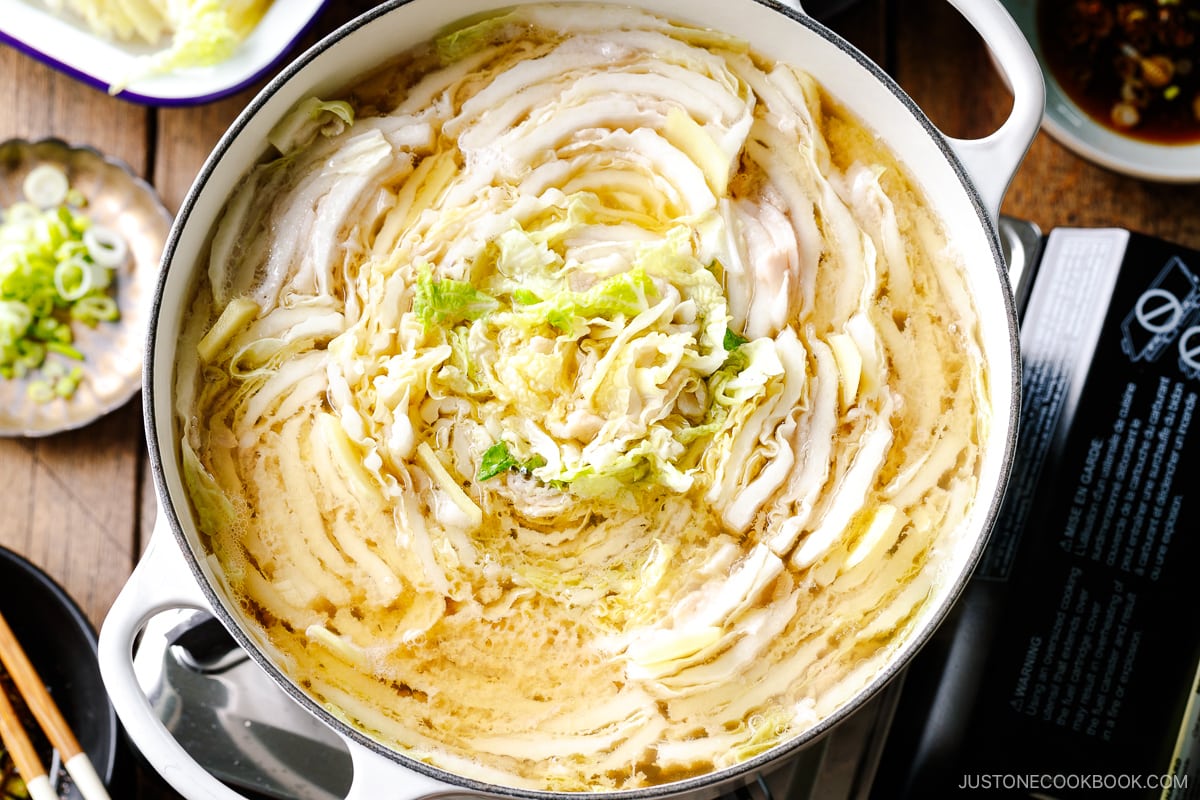
What is Mille-Feuille Nabe?
Mille-feuille nabe (ミルフィーユ鍋, 重ね鍋) is a Japanese hot pot dish named after the French term mille-feuille or “a thousand leaves.” The term refers to a French dessert of puff pastry layered with cream and powdered sugar. Mille-feuille nabe is likewise layered, but instead with tender cabbage leaves and pork belly slices in a favorite style of hot pot in Japanese homes.
Why I Love This Recipe
- Perfect for cold months – We love serving this dish at parties during the chilly months. You can prepare everything ahead of time and cook the hot pot right after your guests arrive.
- Gorgeous presentation – The layers of tender cabbage leaves make a wonderful addition to the dinner table.
- Layers of texture and flavors – The cabbage turns soft yet retains its tenderness, and the pork belly’s fattiness melts into the dashi broth.

Ingredients for Mille-Feuille Nabe
- Napa cabbage
- Pork belly slices
- Ginger
- Dashi (Japanese soup stock)
- Seasonings – soy sauce, sake, and salt
- Dipping sauce:
- Ponzu sauce
- Green onion
- Shichimi togarashi (Japanese seven spice) – optional, for a spicy kick
Find the printable recipe with measurements below.
Jump to RecipeSubstitutions
- Napa cabbage: I love the natural sweetness of napa cabbage (compared to green cabbage), and the leaves are thinner and more tender. If you can’t find it, substitute baby bok choy or sliced daikon.
- Pork belly: JOC readers who don’t eat pork have tried this recipe with thinly sliced beef, and they loved it. Just a quick reminder that beef tends to release more scum as you cook, so be ready to skim off the scum and fat with a fine-mesh skimmer.
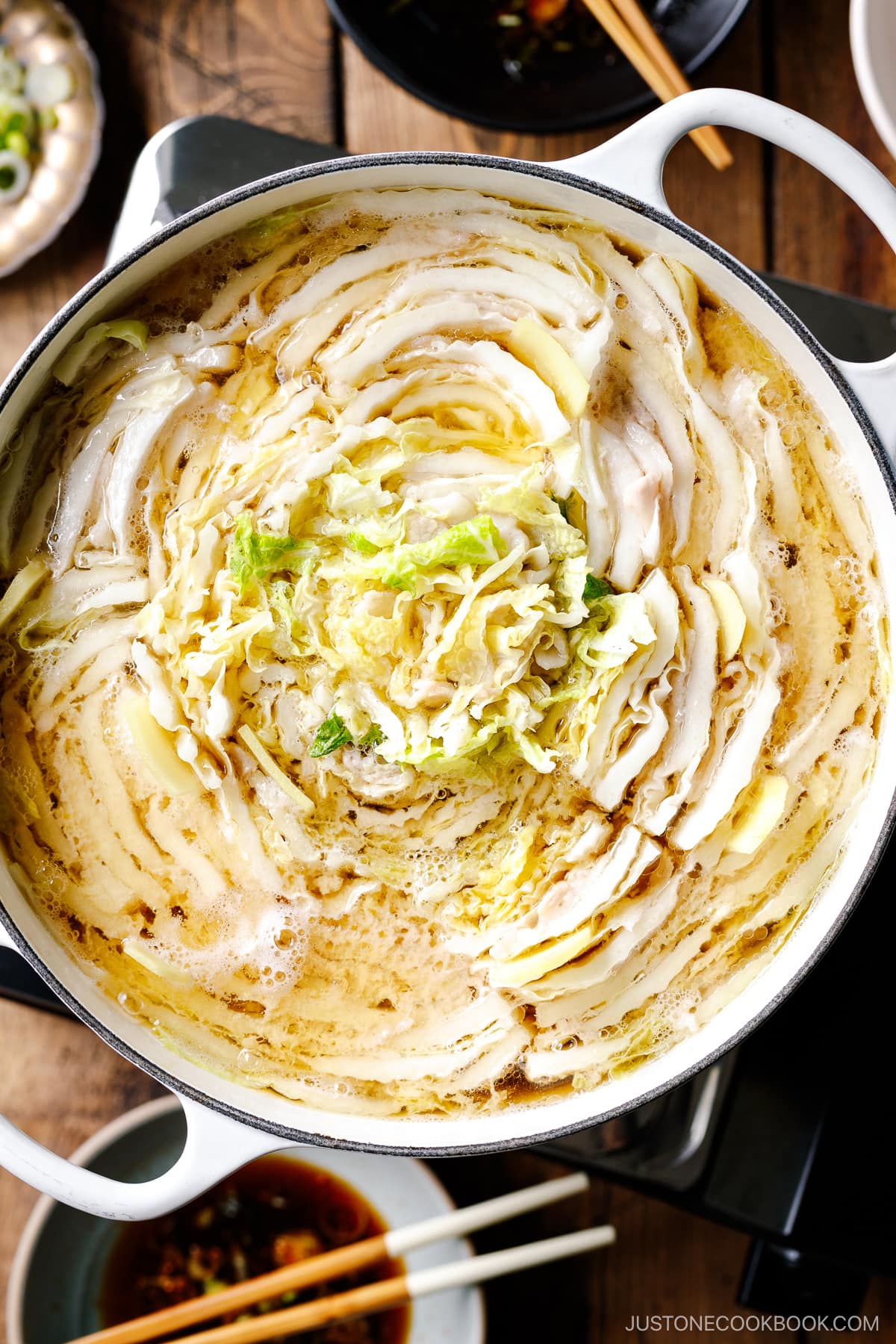
How to Make Mille-Feuille Nabe
Preparation
Step 1 – Make the broth and cut the ingredients. Prepare the soup broth. Slice the vegetables. Cut the napa cabbage into quarters and rinse them under water to remove dirt.
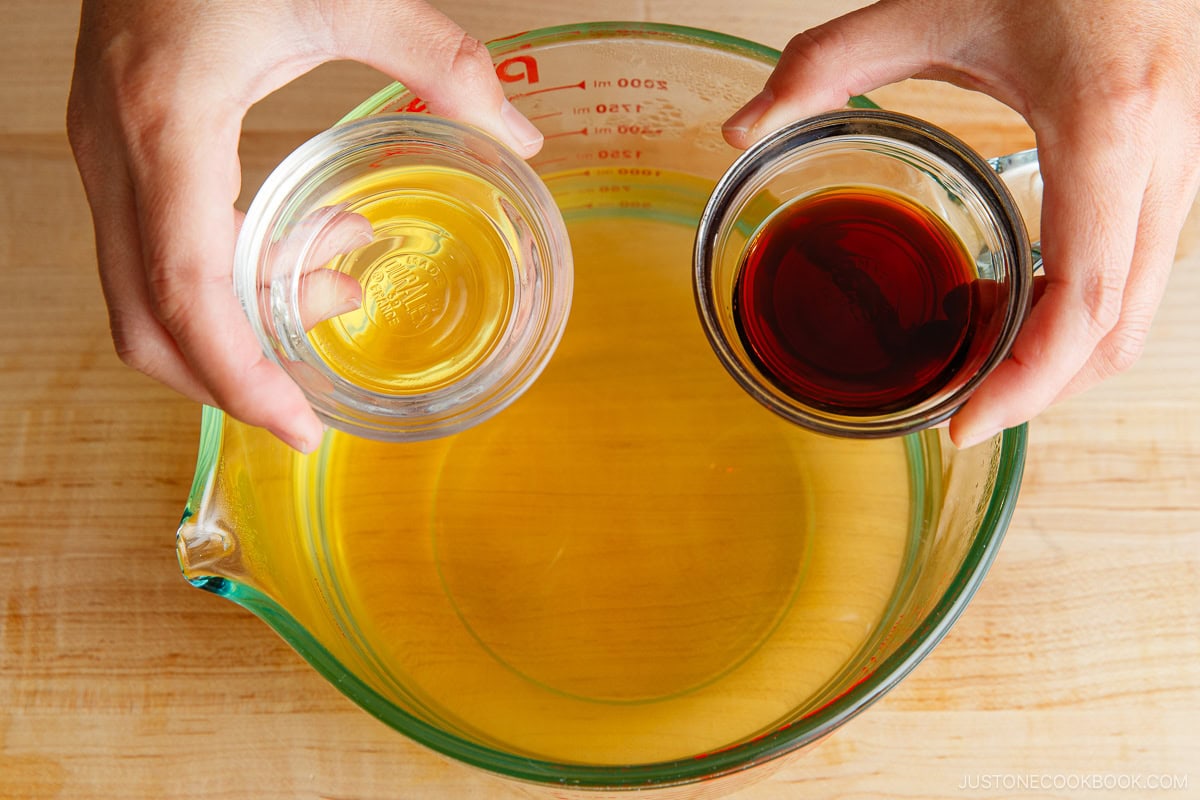
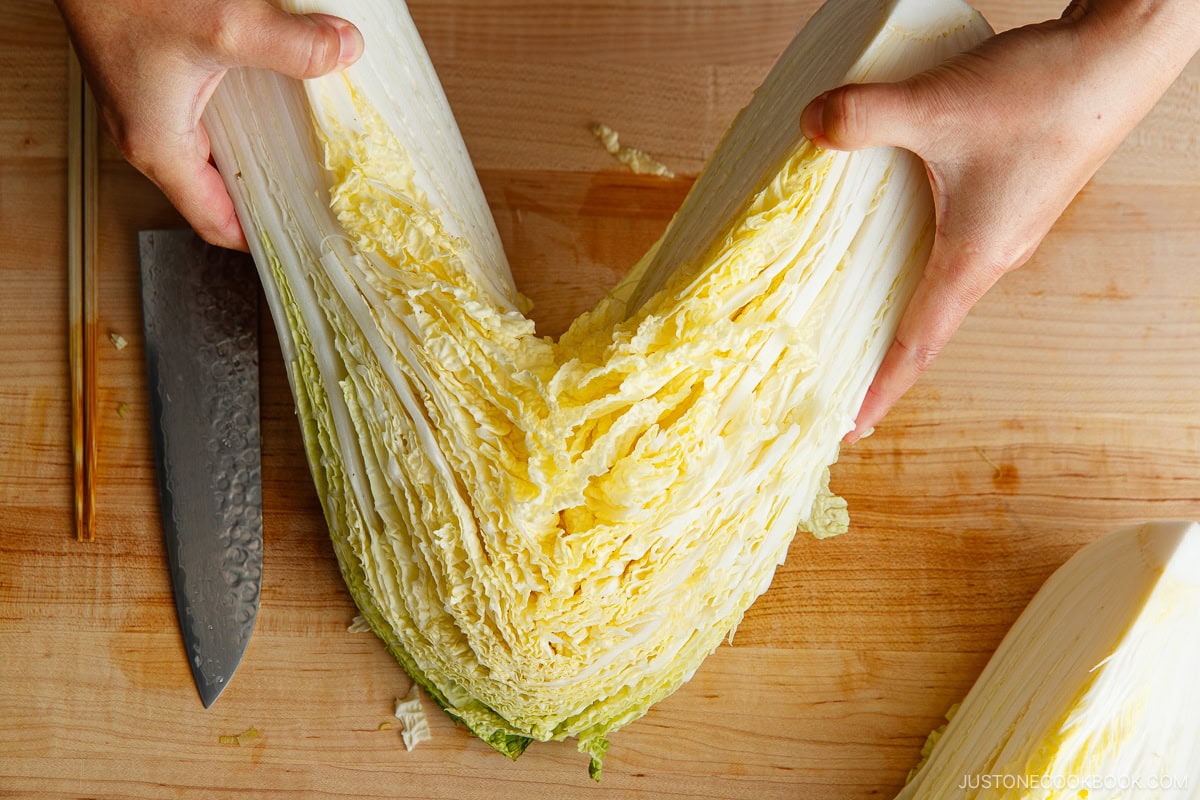
Step 2 – Layer. Layer the slices of pork belly between the cabbage slices, then carefully cut them into layered pieces about 2–2½ inches (5–6 cm) long.
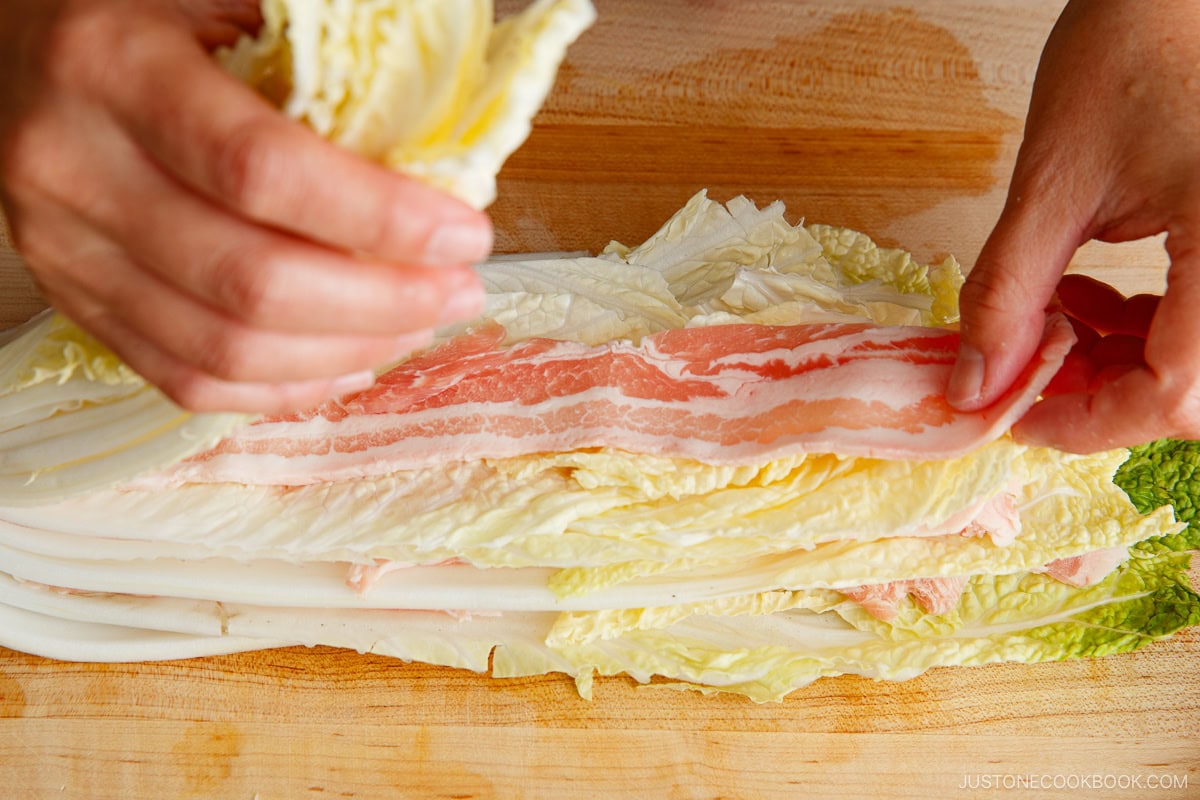
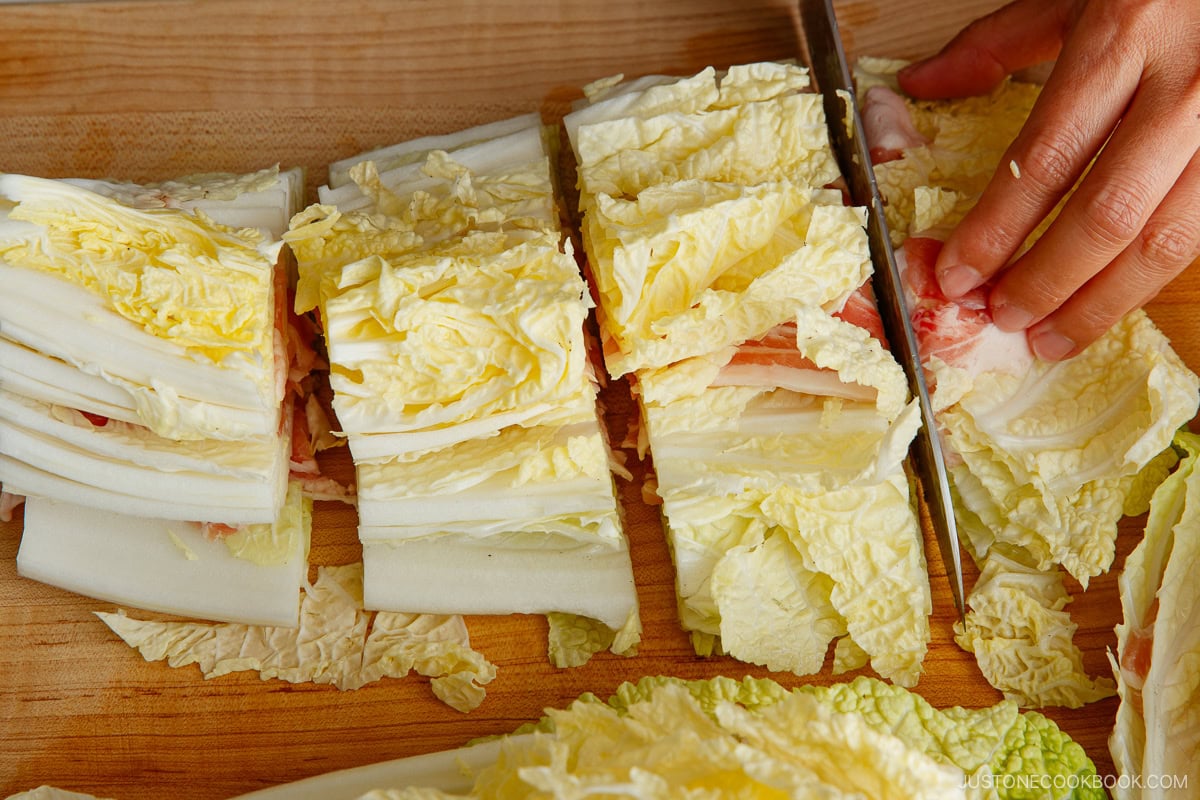
Assemble
Step 3 – Pack the pot. Tightly pack the layered cabbage and pork into a pot, working your way toward the center. Insert the ginger slices between the cabbage and pour the broth on top.
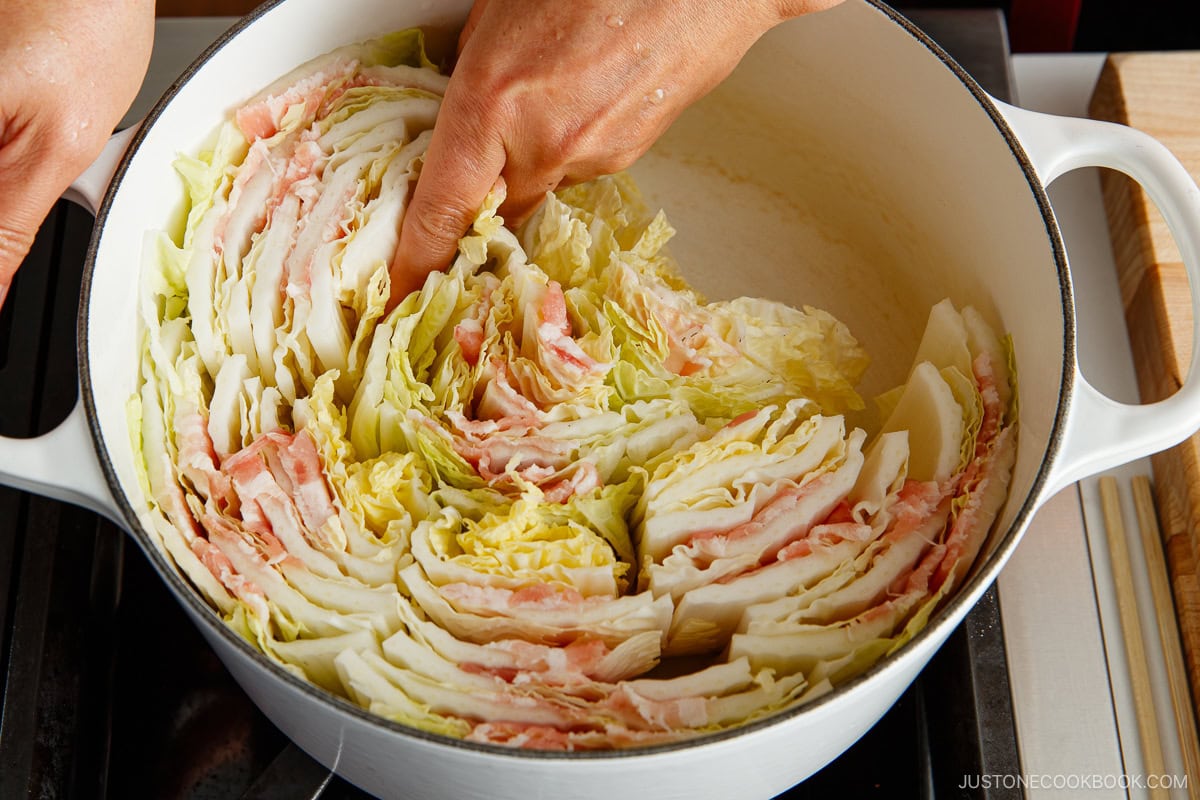
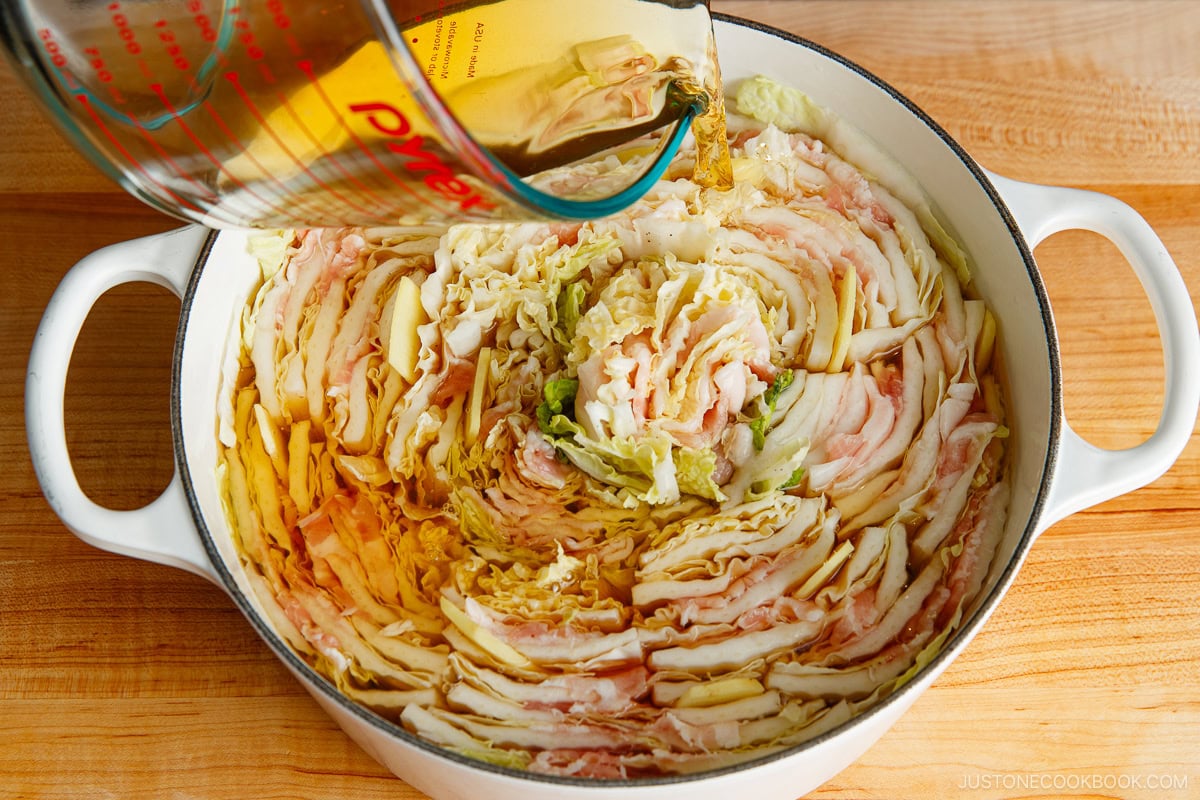
Cooking
Step 4 – Simmer. Cover the lid and bring to a boil. Then, reduce to medium-high heat and simmer until the cabbage is tender and the pork is fully cooked. Meanwhile, make the dipping sauce by combining the sauce ingredients in a mixing bowl.

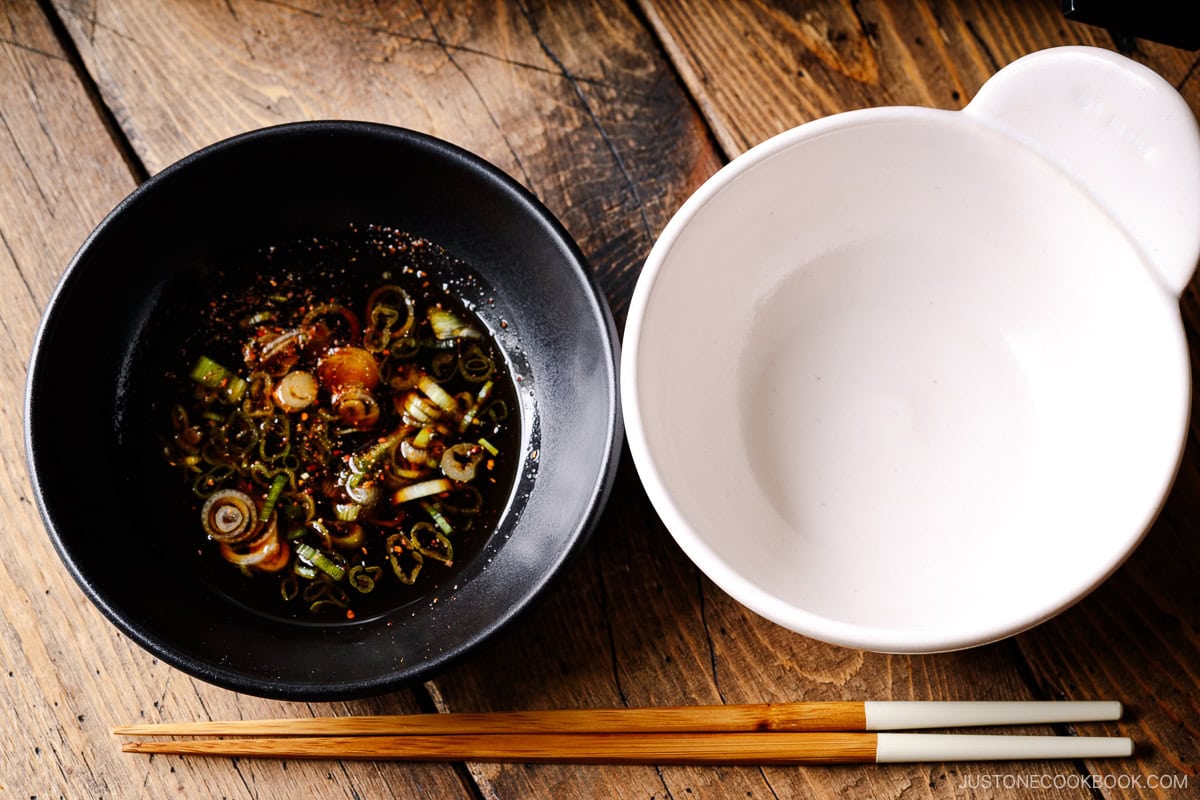
Step 5 – Serve. Serve with ponzu dipping sauce on the side.


Nami’s Recipe Tips
- Running out of cabbage? It can happen, especially if this is your first time making this dish. I recommend having shimeji mushrooms or enoki mushrooms as a backup filler for any empty space in the center of the pot.
- Pack the layers tightly! The key to making this nabe is ensuring the layers are tightly packed in. Cabbage releases water and shrinks as it cooks, causing the layers to loosen.
- Start by packing from the outer edges of the pot and work your way toward the center. I usually place the thicker cabbage leaves near the pot’s edge and the tender leaves in the center.
- Use one hand to hold the layers in the pot and the other hand to add more layers. Don’t worry if the layers become a bit loose; you can adjust them by bunching them up against each other as you add more.
Variations and Customizations
- Make it vegan. Some of our readers use Vegan Dashi and mushrooms or thinly sliced vegetables instead of pork belly, and they love it!
- Add more vegetables. Napa cabbage is the traditional choice, but you can add other thinly sliced veggies.
- Make a finishing course. With the leftover umami-packed soup, make a final dish called shime (〆, しめ) to end the meal. Simply simmer one serving of udon noodles, chuka soba (ramen noodles; Mr. JOC’s favorite), or steamed rice in the broth. I like to make Zosui with the rice by drizzling in the beaten egg as it simmers, then topping it with salt, ground white pepper, and chopped green onion.
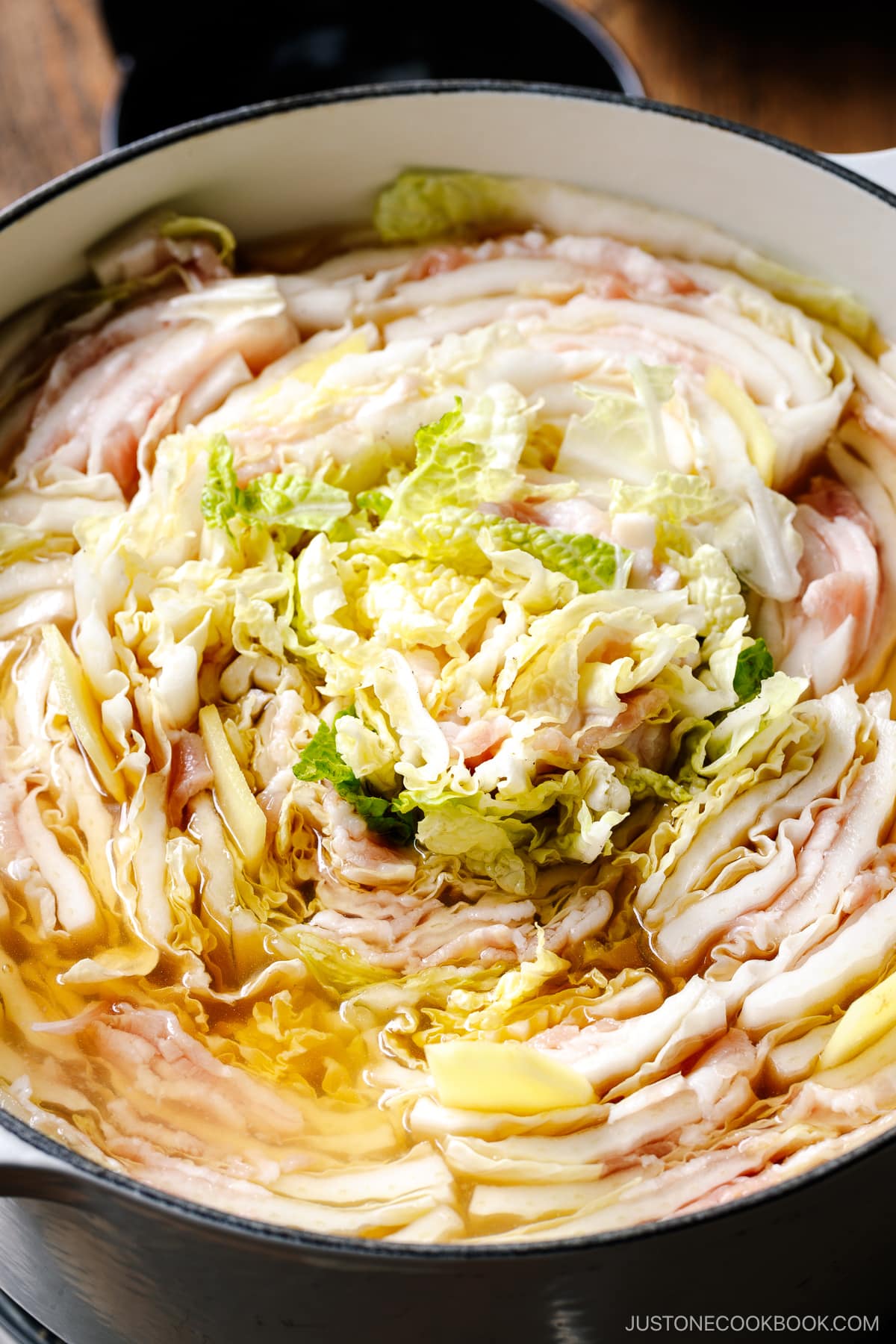
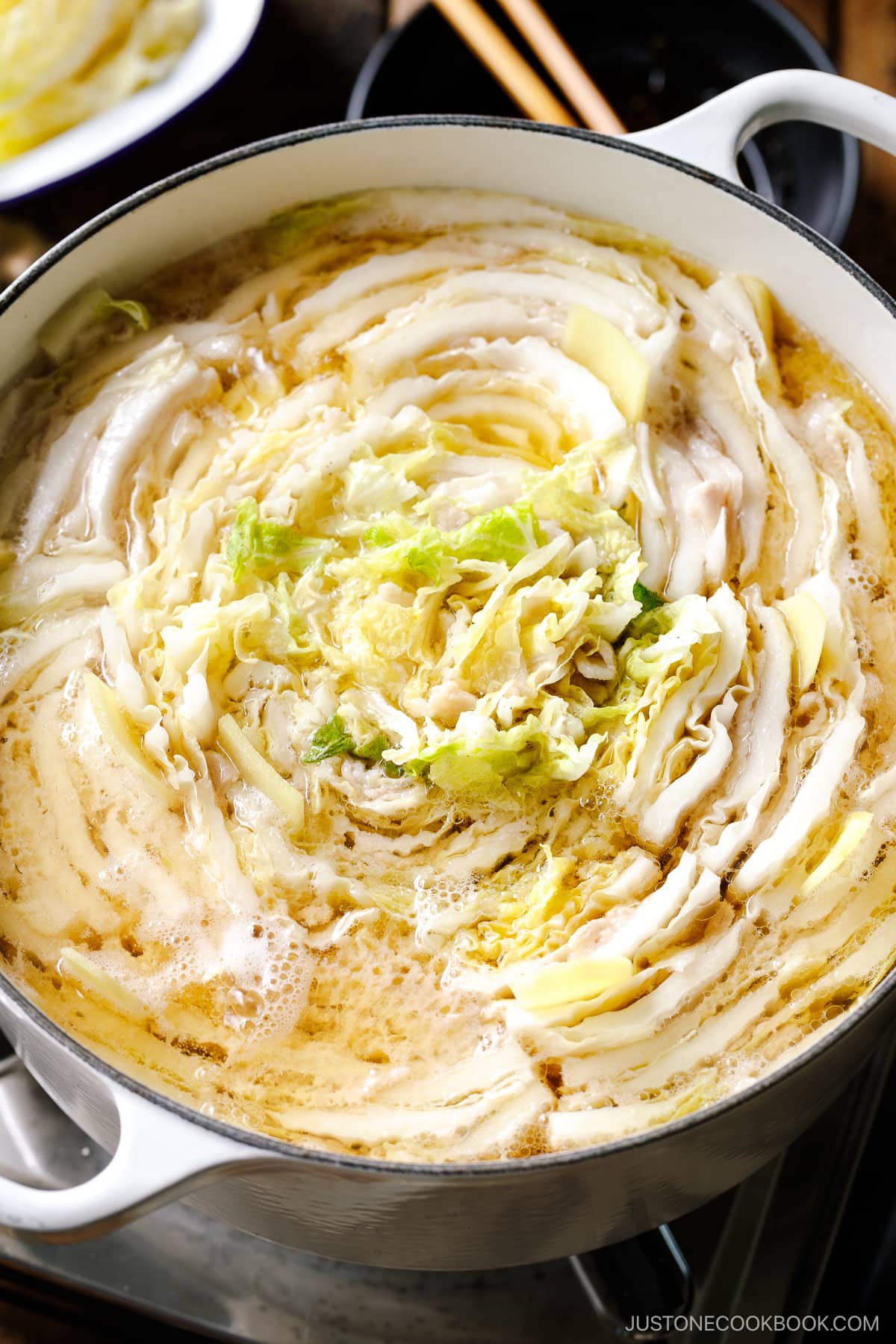
What to Serve with Mille-Feuille Nabe
- Rice – Learn How to Cook Japanese Rice in a Pot on the Stove.
- Sides – Try Kinpira Gobo, Green Bean Gomaae, and Asazuke (Japanese Lightly Pickled Vegetables). Make them ahead of time. These dishes add a wonderful flavor and texture contrast.
- Noodles – My kids like to add frozen udon noodles to the leftover broth for the finishing course.
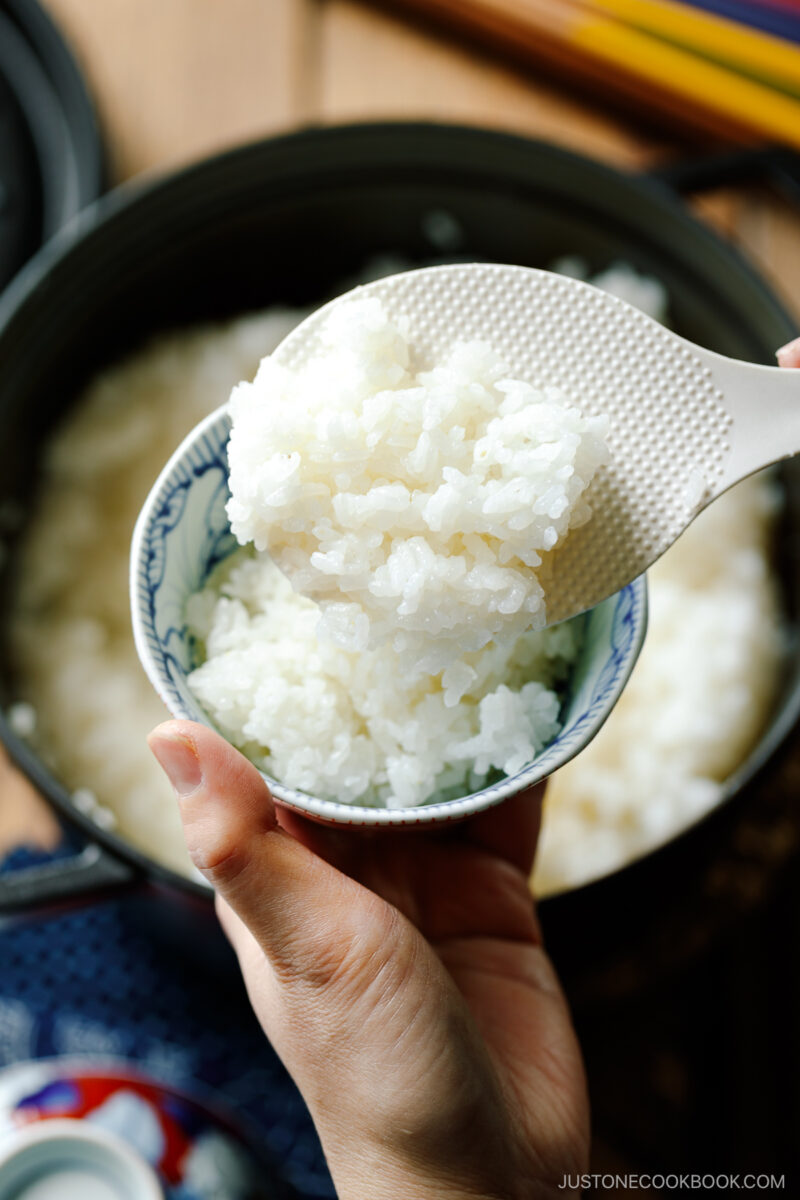


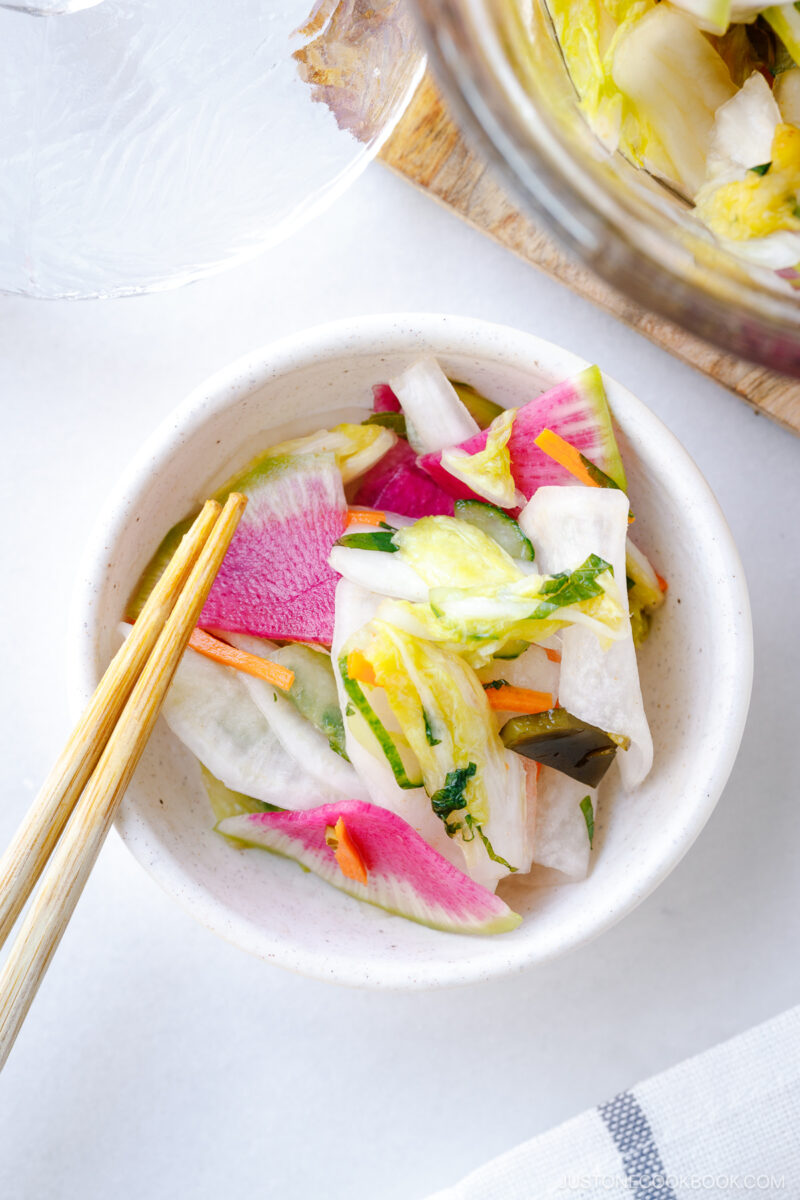
Storage and Reheating Tips
To store: Allow the nabe to cool uncovered, then store in an airtight container for up to 3 days in the fridge or up to 1 month in the freezer.
To reheat: Simmer leftovers in a saucepan over medium heat until warm, or microwave in 30-second intervals.
Frequently Asked Questions
I do not recommend using bacon in place of pork belly, as bacon is very salty and can often times be too fatty.
Yes, you can prepare and assemble everything ahead of time and store it in the refrigerator. Hold off on adding the broth and cooking the cabbage until right before you’re ready to serve.

Mille-Feuille Nabe
Video
Ingredients
- 1 head napa cabbage (4 lbs, 1.8 kg)
- 1½ lb sliced pork belly (see Notes for where to buy it pre-sliced; or learn how to slice meat thinly at home; do not use bacon, since it‘s too salty)
For the Broth
- 8–10 slices ginger (peeled and thinly sliced from a 1-inch, 2.5-cm knob)
- 5 cups dashi (Japanese soup stock) (use standard Awase Dashi, dashi packet or powder, or Vegan Dashi)
- 2 Tbsp sake
- 1 Tbsp soy sauce
- ½ tsp Diamond Crystal kosher salt
For the Dipping Sauce
- 1 green onion/scallion
- ponzu
- shichimi togarashi (Japanese seven spice) (optional, for a spicy kick)
Instructions
- Before You Start: Make 5 cups dashi (Japanese soup stock) of your choice. Here, I'll show you a quick version using my favorite dashi packet. First, add 2 dashi packets to 5 cups water in a saucepan. Start cooking over medium heat. When it reaches a boil, reduce the heat to medium low and simmer for 2–3 minutes. Turn off the heat. Remove the packets from the saucepan, shake them a few times to release more flavor, then discard them. The dashi is now ready to use.
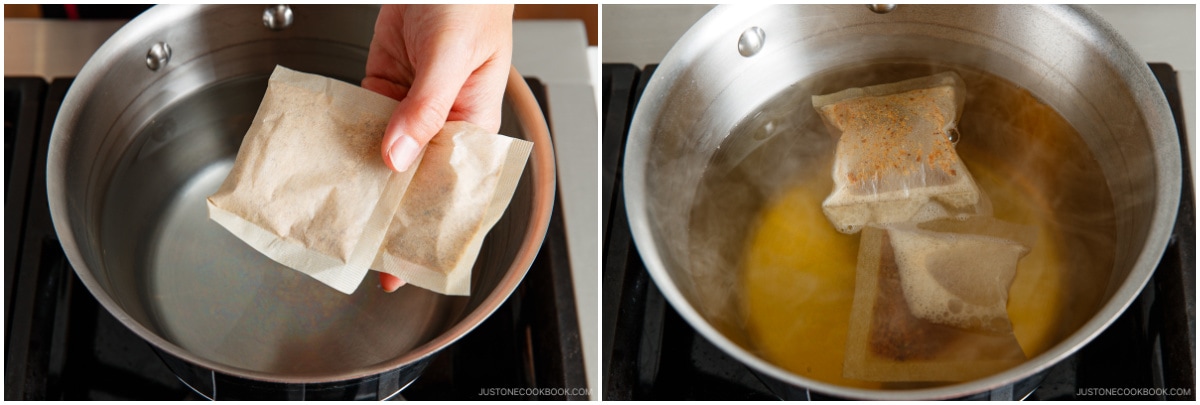
- Gather all the ingredients.
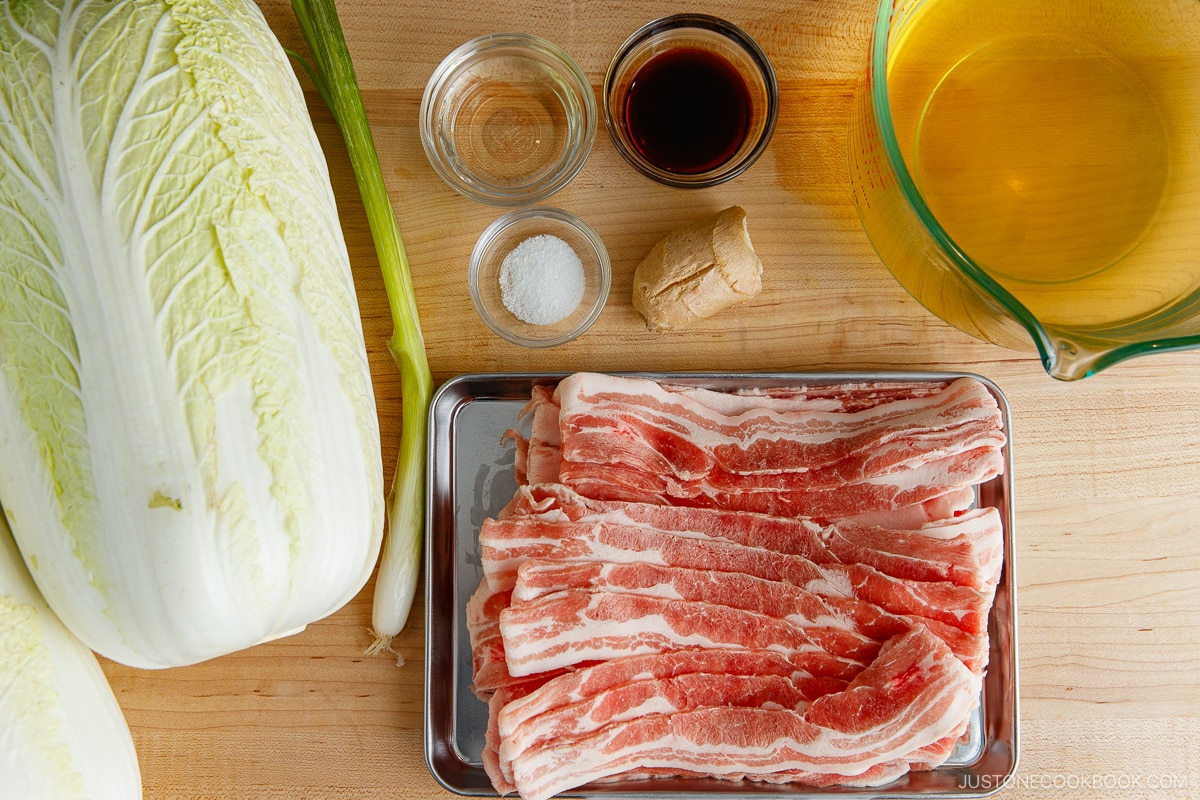
To Prepare the Ingredients
- To make the soup broth, combine 5 cups dashi (Japanese soup stock), 2 Tbsp sake, 1 Tbsp soy sauce, and ½ tsp Diamond Crystal kosher salt in a measuring cup or mixing bowl. Tip: Don’t reduce the salt since the napa cabbage will release liquid during cooking and dilute the soup.
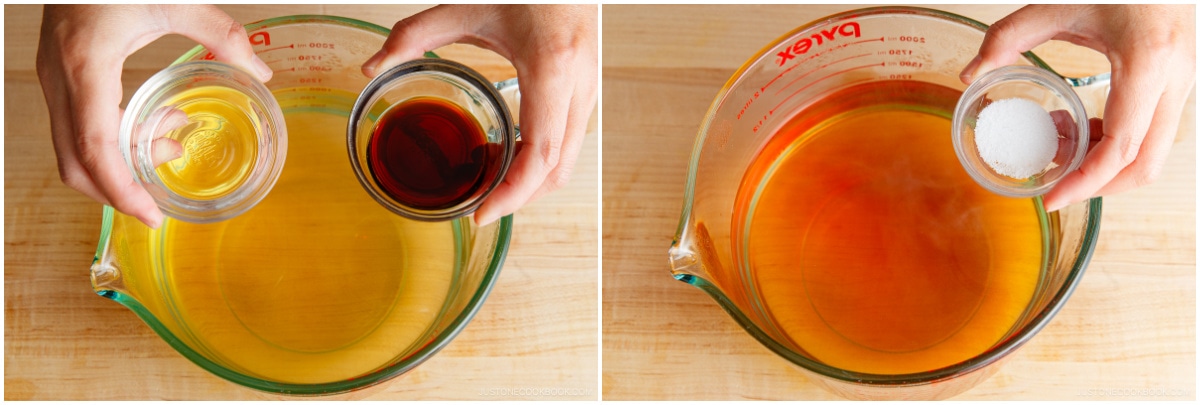
- Peel and thinly slice the ginger knob into 8–10 slices ginger and set it aside.
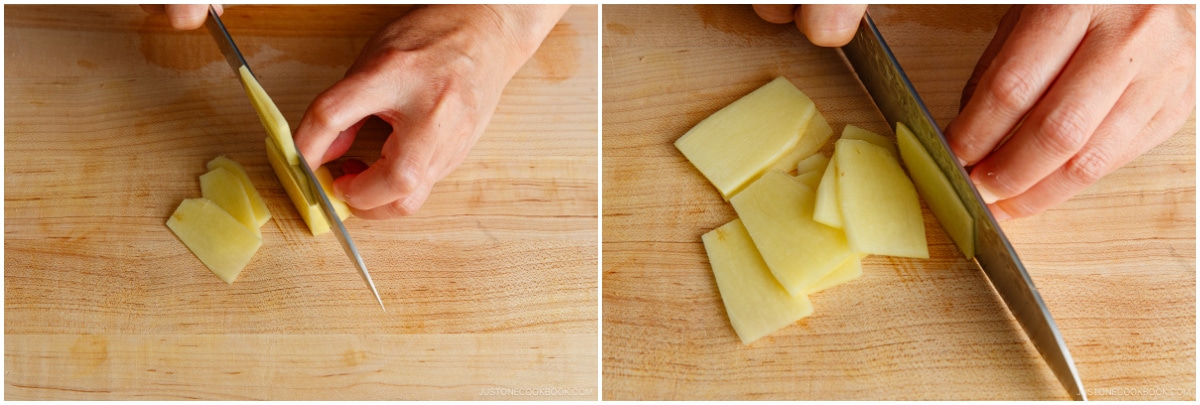
- Thinly cut 1 green onion/scallion. Put the green onion in a small serving bowl to add later to the dipping sauce.
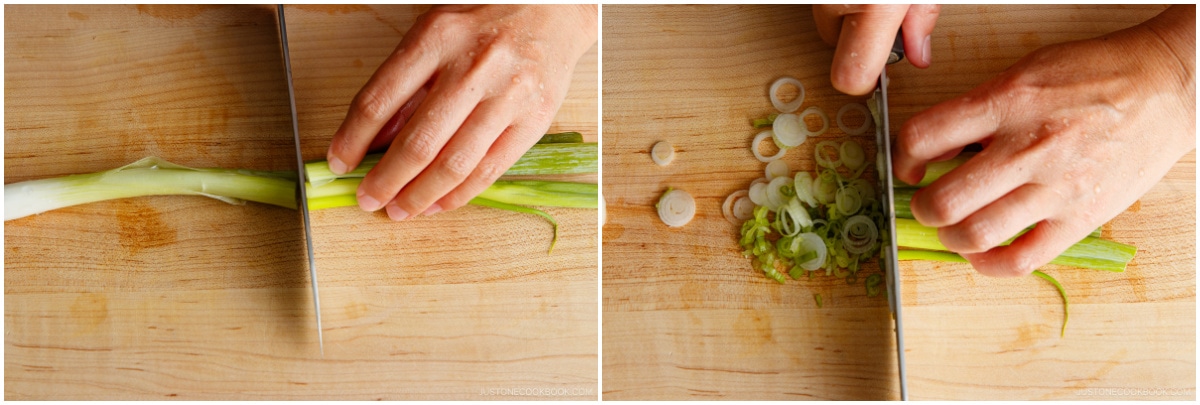
- Cut 1 head napa cabbage lengthwise into quarters. I like to cut just the white bottom half with a sharp knife, then pull apart the leafy top half with my hands. By tearing it naturally, you lose fewer leaves compared to slicing. DO NOT cut off the core from the wedges yet. They keep the leaves attached and make layering the pork belly much easier.
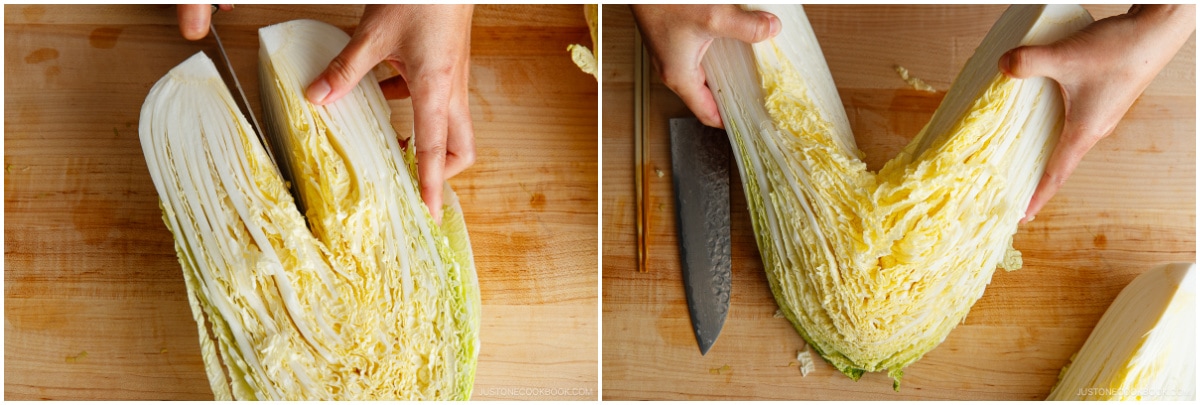
- Carefully wash the leaves without detaching them from the core. Drain well. Don’t throw away any leaves that naturally come off while rinsing. We’ll use them later on.
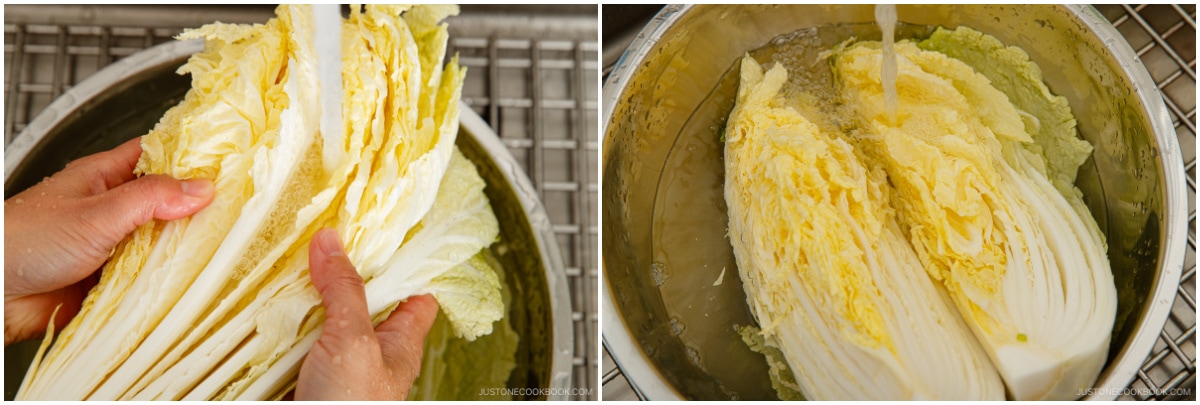
To Make the Layers
- Layer 1½ lb sliced pork belly into the napa cabbage wedges by placing one pork belly slice between each of the leaves. If the pork belly is longer than the cabbage wedge, trim the pork with kitchen shears and layer it in other parts of the wedge. If you have extra pork belly, put an additional slice in the outer layers that have wide leaves.
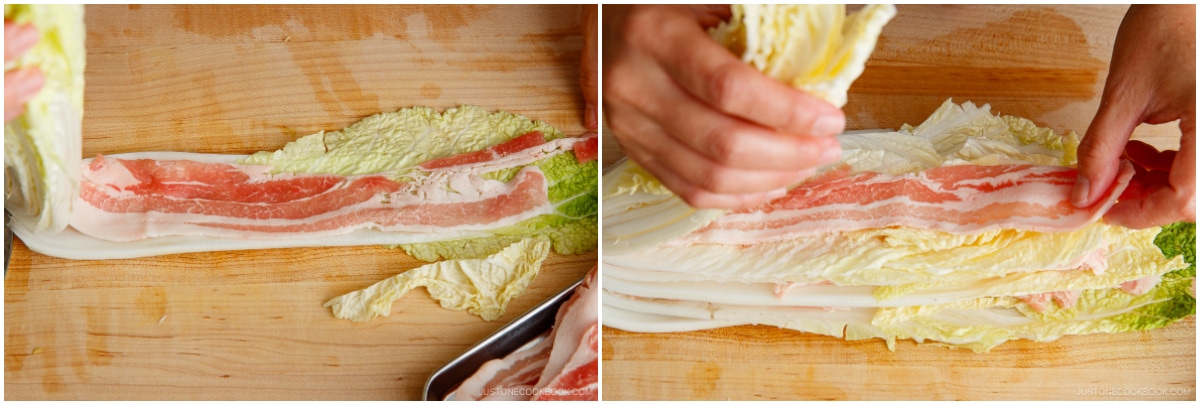
- Once you‘ve tucked in the pork belly slices, carefully cut off the hard cabbage cores without disturbing the layers. Cut each wedge into 4 pieces that are each about 2–2½ inches (5–6 cm) long. Keeping the layers of cabbage and pork neatly stacked as you slice.
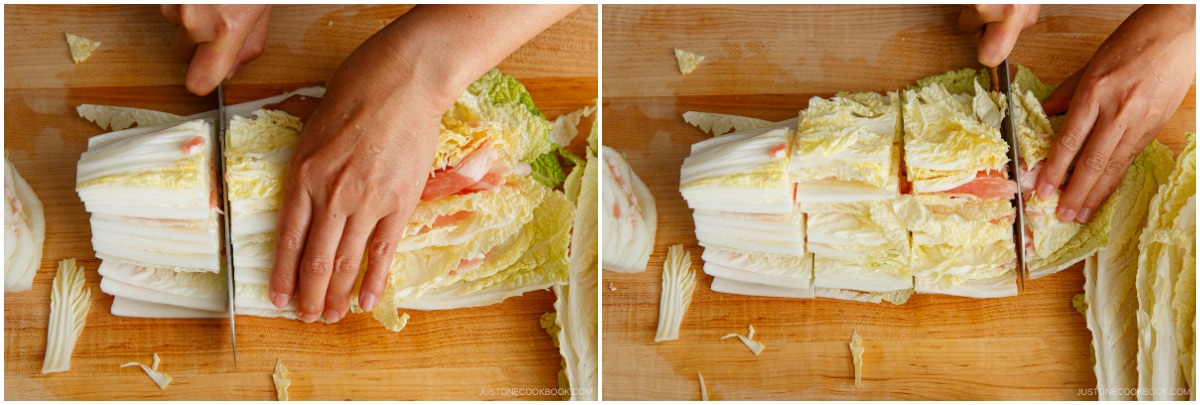
To Pack the Pot
- Prepare a donabe or regular 10-inch pot (I used a 4.5 QT Le Creuset pot; if you‘re doubling the recipe, use two 10-inch pots or one larger pot). Begin to pack the ingredients starting from the edge of the pot and working your way toward the center. Turn the stacks on their side so the pink and green layers are visible. Position the layers parallel to the pot‘s side so they eventually form concentric circles in the pot.
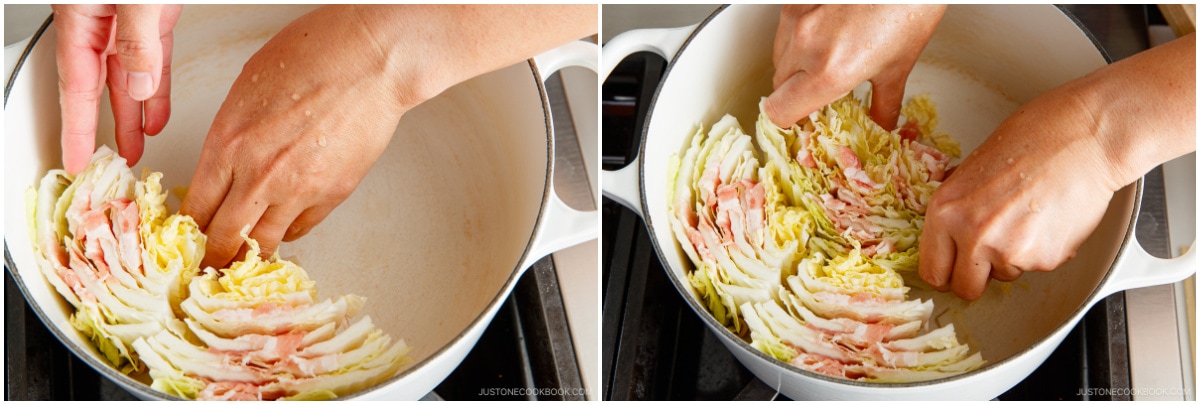
- I usually place the thicker cabbage leaves near the edge of the pot and the tender leaves in the center. Make sure to pack the pot tightly as the layers will become loose during cooking.
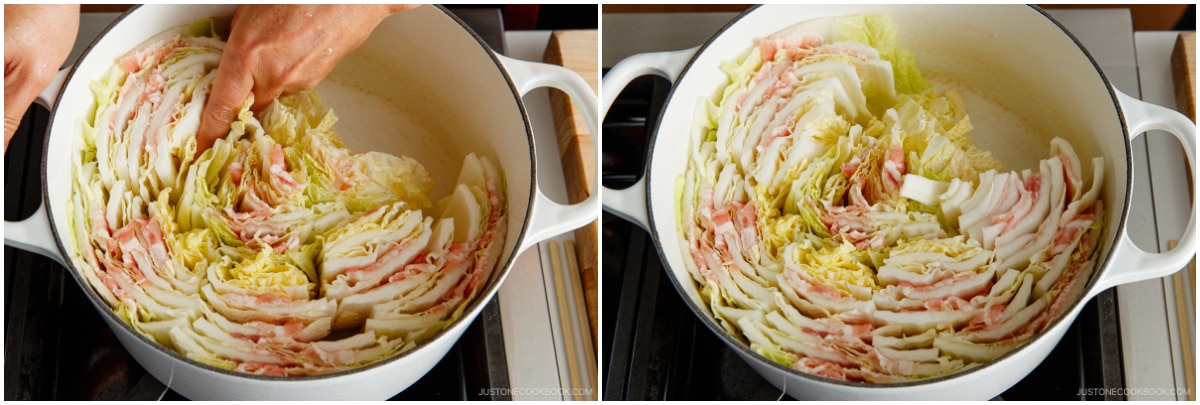
- If you don’t have enough layers to pack the pot tightly, consider using a smaller pot or place other ingredients in the center. Here, I stuffed the napa cabbage leaves that came off when I cut and rinsed the cabbage. You can also put enoki mushrooms or shimeji mushrooms in the center.
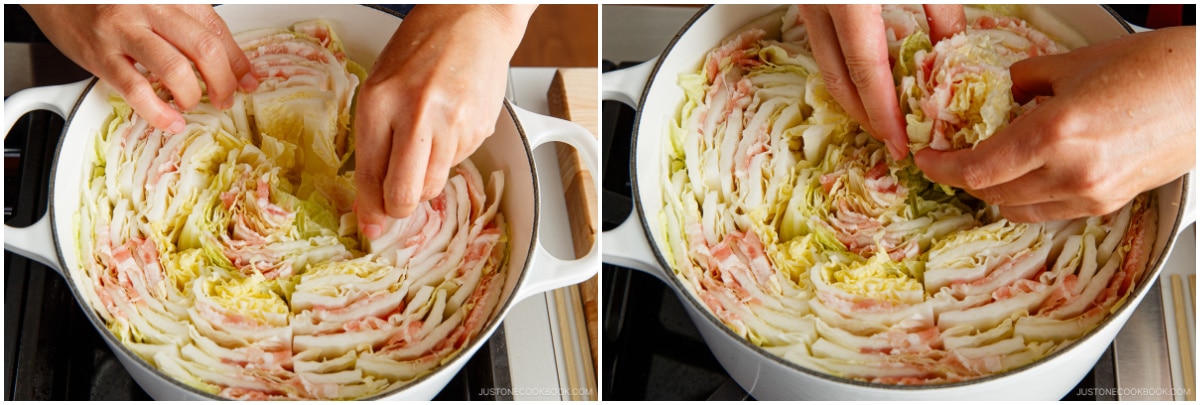
- If you have extra layers, hold them in a deep baking dish or a container with a tall rim. You can add them to the pot later after you‘ve remove most of the cooked layers.
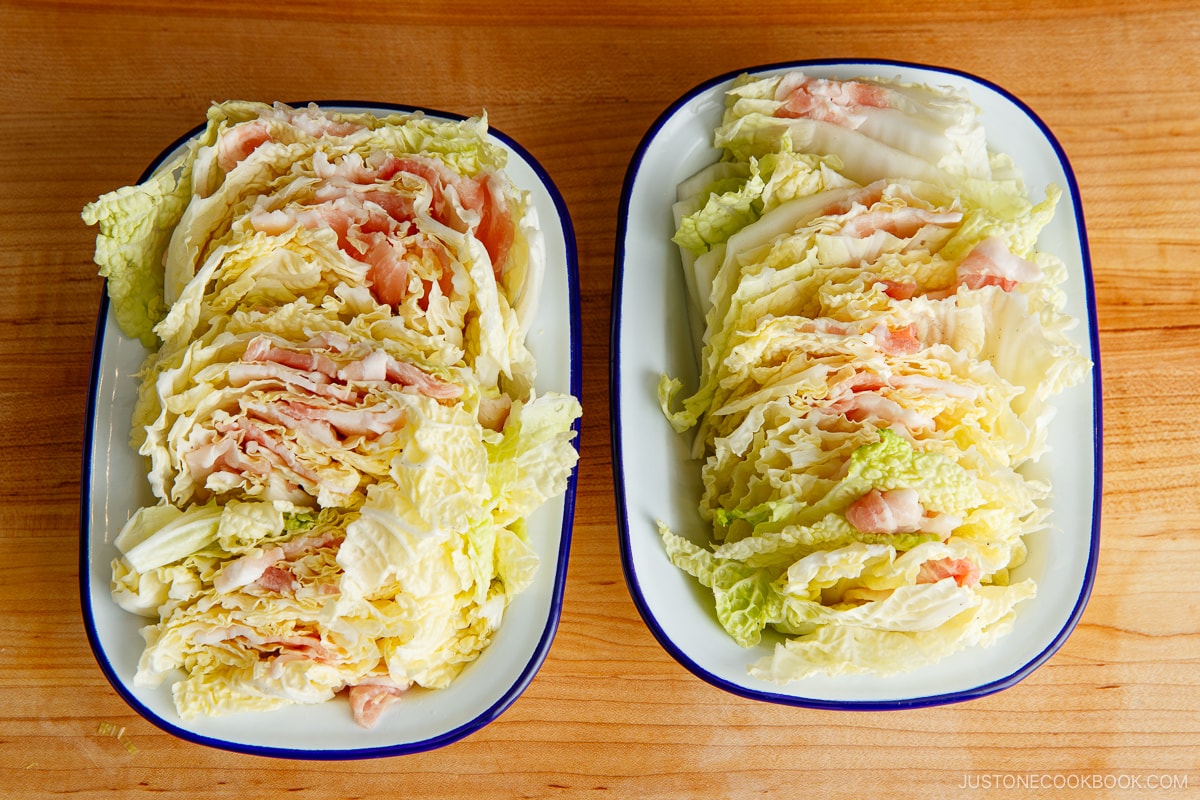
- Insert the thinly sliced ginger between the layers.
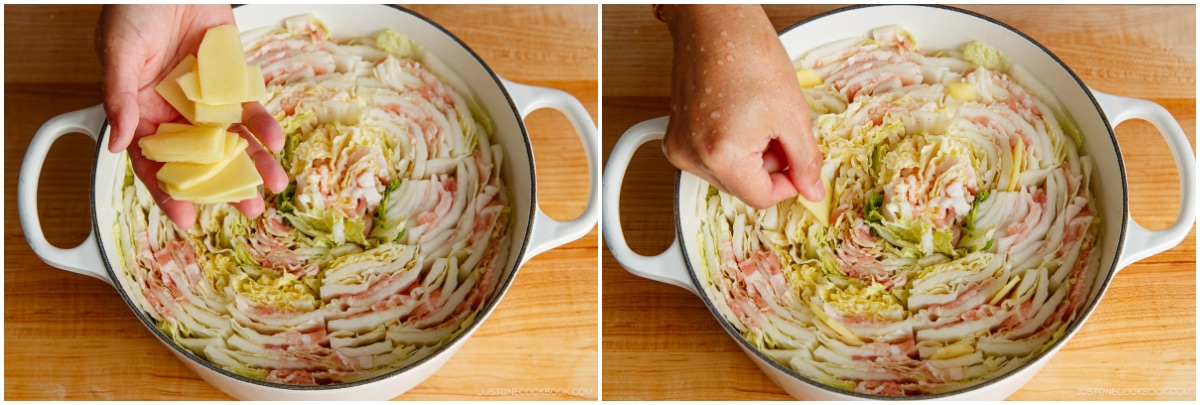
- Pour the soup broth into the pot with the cabbage and pork layers. If you are cooking at the table, bring the pot to the table. Otherwise, start cooking it on the stove (see below).
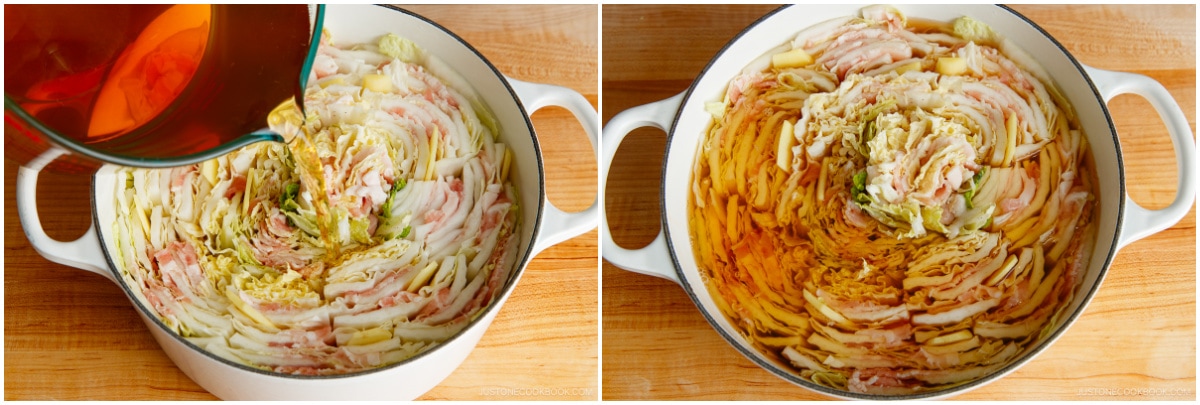
To Set up the Table
- At each place setting, prepare a medium bowl and a small dipping bowl for each person. To cook at the table, set it up a portable gas stove and place the pot on it.For the dipping sauce, add ponzu, the chopped green onion/scallion, and optional shichimi togarashi (Japanese seven spice) to the small bowls.
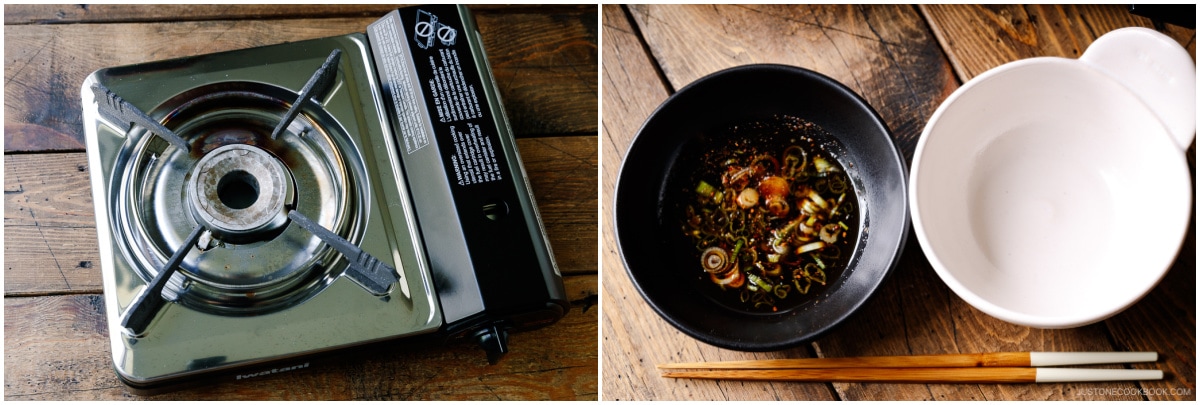
To Cook and Serve
- Start cooking, covered, on medium-high heat. Once boiling, skim off the scum and fat on the surface using a fine-mesh skimmer. Then, reduce the heat to medium low and cook covered until the napa cabbage is tender and the pork belly is cooked through, roughly 8–10 minutes. Serve it hot dipped in ponzu sauce and enjoy!
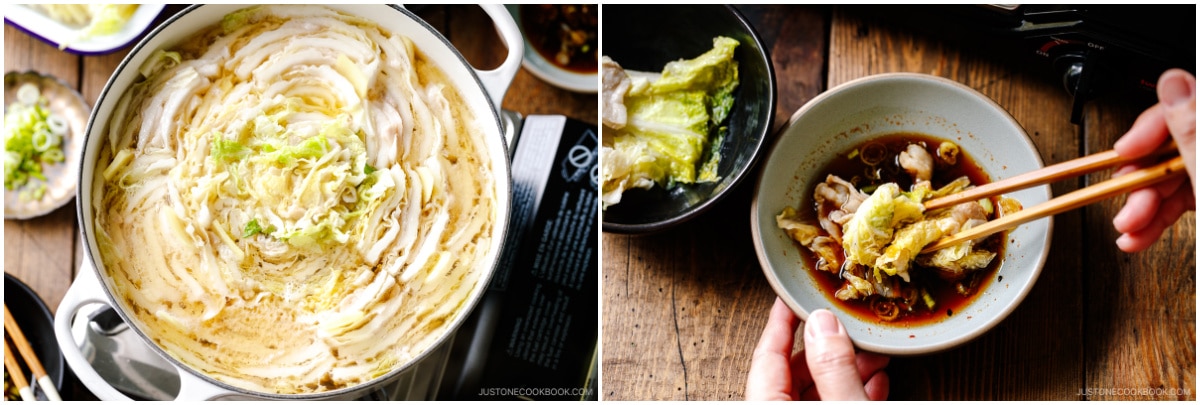
To Store
- You can keep the leftovers in an airtight container and store in the refrigerator for up to 3 days or in the freezer for a month.
Notes
Nutrition
Editor’s Note: This post was originally published on January 6, 2016, and updated with a new video and new images on November 10, 2023. It was republished with updated content on March 30, 2025.

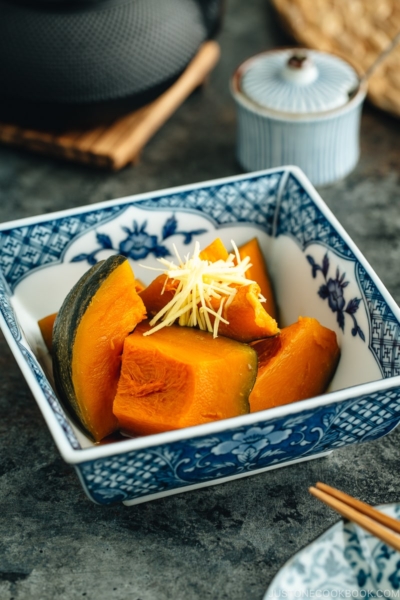
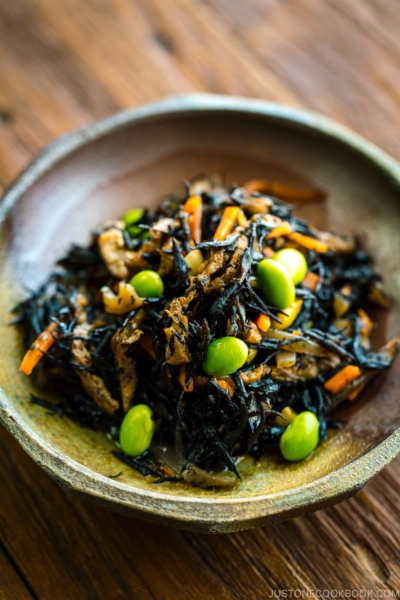
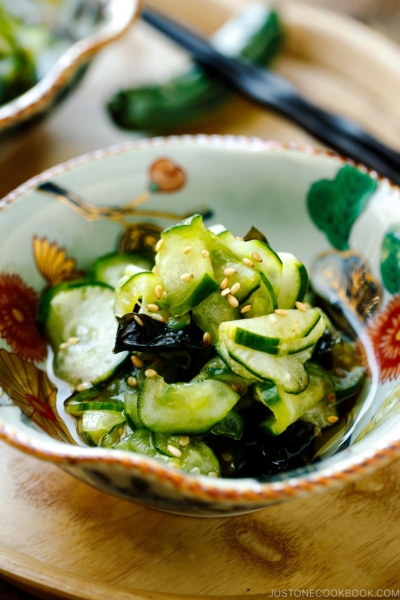
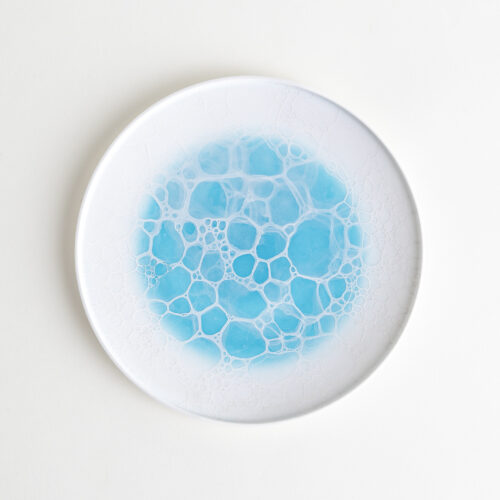
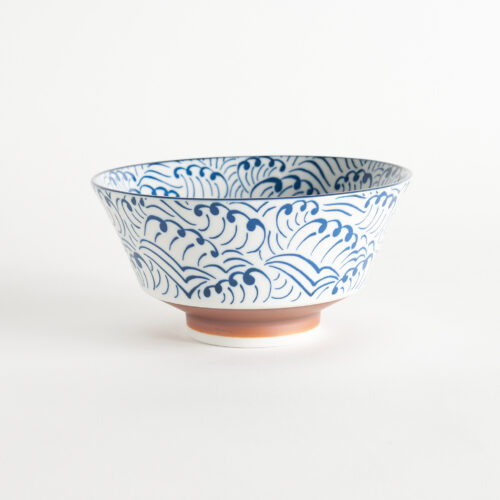
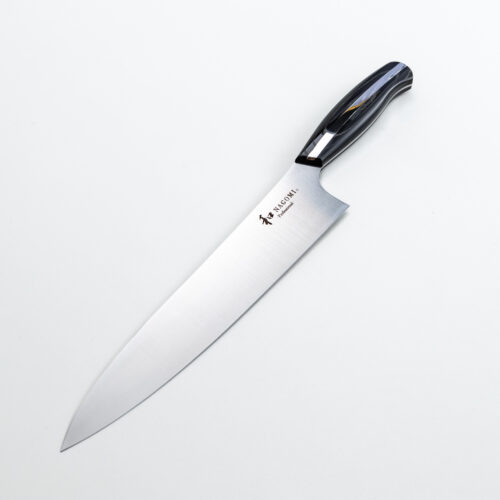
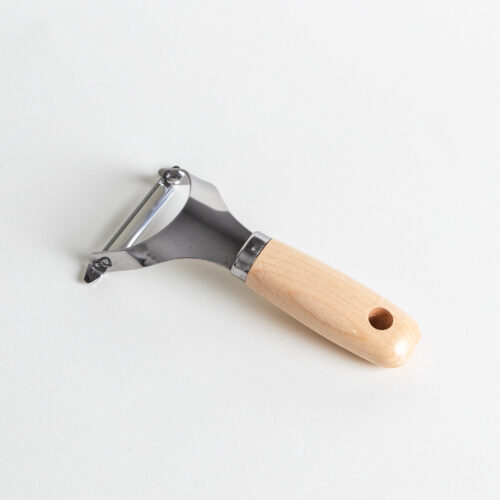
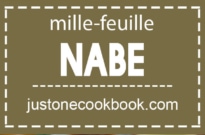
Cooked this today – it was delicious!
So happy to hear that! Thank you!!!
Dear Nami-san,
Wonderful recipe!!! So creative.
However not a pork eater I am thinking of using a vegetarian replacement – possibly tempeh – do you have any ideas?
Thank you for all of your work for all of us!
Sincerely,
Joyce
HI Joyce! Thank you for your kind words! To be honest with you, I had never tried tempeh before… so I can’t quite figure out how it’s like. I am so sorry… I want to say it should work, from imagining how it is like… Sorry, I wish I could give you a better advice.
This recipe is absolutely delicious, and exactly what I needed after a long day… I made half the recipe with a handful of enoki, and now have some amazing leftovers to look forward to in the next few days 🙂 Thank you Nami!!
Hi Lisa! Thank you so much for trying this recipe! I’m so happy to hear you enjoyed this recipe. Thanks for your kind comment. xo 🙂
Hi Nami, can I prepare this dish in the pot overnight in fridge and cook the next day?
Hi Lian! Sure you can do that. 🙂 Hope you enjoy this dish!
I want to make this but instead of pork belly, what part of the chicken can i use? (Cooking for people who don’t eat beef or pork)
Hi Zane! Chicken tends to get tough as you cook for a longer time, so it’s not meant for a hot pot like this. I recommend chicken thigh meat (breast can be dry as you overcook it) but it’s harder to make into layer as you will need thin layer to make into “1000 layers”. Though Asian grocery stores (specifically chinese) has thinly sliced chicken breast meat, and that might work for this recipe. Just don’t over cook it. It gets chewy and tough. Hope this helps. 🙂
Hello Nami san,
Thank you for sharing this recipe. Should the soup stock cover all cabbage at the start?
Thank you!
Hi Karen! No, as you see in my video, you don’t see the liquid going over the napa cabbage. Napa cabbage has so much moisture inside so as soon as you cook, the moisture starts to come out. As napa cabbage gets wilted, all the food will be under the soup. 😉 Enjoy!
Hello Nami san! This is a truly gorgeous dish! I made it once and had such fun folding the meat between the leaves. It was a bonus that it turned out restaurant-perfect and everyone in the family enjoyed it. I’ll be making it more often!
Hi Karen! So happy to hear that! Thank you for trying this recipe. It’s really easy and simple, yet the flavors of the broth are amazing. Glad you and your family enjoyed it. Thanks so much for your kind feedback. 🙂 xo
I made this tonight for my husband and I, we even added the mushrooms and everything. My husband couldn’t stop praising this dish. It is so simple yet so amazingly tasty! Thank you!
Hi Tammy! I’m so happy to hear that you two enjoyed this dish! Thank you for trying this recipe! 🙂
This recipe was phenomenal! Even in the hot summer weather, we loved it. I look forward to making it again. Mahalo, Nami!
Hi Debbie! So happy you liked it. We eat hot pot all year round… mainly because it’s easy for me to prepare (busy night meal!). 🙂 Thank you for your kind feedback!
Hi Nami, thanks for sharing another great recipe! This is perfect for the cold winter in NYC. I am wondering if I can use something on the lighter side than the pork belly? Say salmon? or tofu? Thanks!
Hi Siyun! Sure, I’ve never tried with salmon, and I’m afraid salmon might break into pieces (without skin, maybe even with skin on) after cooking. You can use pork tenderloin slices (for shabu shabu) to reduce fat in the broth. Surprisingly though, it’s not as oily as it sounds. Tofu is okay too, but need to use firm tofu so it won’t break into pieces. Hope this helps… 🙂
Is there a vegetarian version of this? I suppose I can just omit the pork belly, but is there something you might recommend as a substitution? I guess some seitan or something like that would work.
Hi Heather! Sure! You can use peeler to to thinly slice carrot, daikon (or turnip etc), zucchini, etc. Or thinly slice vegetables of your choice and layer them. You can sandwich tofu in between if you like, but personally just vegetables sounds good. Make sure all the ingredients are relatively same thickness so it’s all cooked at the same time. Hope you enjoy!
Tried it twice here in Italy, with family and with friends: this dish amazed everyone, every time! We got interesting comments that despite its crystal clear Japanese taste, style and ingredients, this recipe builds a cultural bridge to one of the big classics in italian cuisine (the “bollito misto”) . I might serve it in that context, one day.
Not having Shichimi Togarashi at hand I had to cheat by blending together in a mortar chili powder, white sesam, grated ginger, roasted fresh orange peels, szechuan peppercorns, long peppercorns. (everything I could find at home that fit somehow).
I any case, thank you for this recipe, it will become a classic in our family!
Hi Daniele! I’m so happy to know that you can cook this dish in Italy! I know some ingredients can be hard to find, but I’m really happy to hear that you could still adapt this Japanese food and cook in Italy. Thank you so much for trying this recipe. I’m glad your friends and family enjoyed it too! Thank you!!
Thanks for posting this amazing dishes. It is easy to make and super yummy. My hubby liked this so much that he finished everything off from the pot.
Hi Michelle! Hahaha! So happy to hear that! The broth is delicious and we love making porridge or noodles out of this soup! Thank you for your kind feedback! 🙂
Hi, thank you for sharing this recipe! I made it tonight, and my husband and I both loved it! I will be adding this to my recipe rotation. ????
Hi Quyen! Yay! I’m so happy to hear you and your husband enjoyed it! Thank you for trying this recipe. 🙂
Aloha Nami!
I made this for my husband and daughter tonight and it was a huge hit!!! In Hawaii we say so ono (so delicious)! Thank you very much for sharing your recipes. I’ve enjoyed making some of them and they are always enjoyed in our home. For New Years I made your Mizu Yokan for my mom and she was so happy! Thank you again for sharing and making our meals a special thing. Wishing you and your family a blessed 2016!
Hi Amy! Yay! Thank you so much for trying this recipe already! So happy to hear your family enjoyed this dish! Yes, this is very ono!!!! I’m glad to hear you like my recipes and thanks for trying them. Your mom liked mizu yokan? I’m flattered! I’m sure you made it very nicely too! 🙂 Happy New Year to your family as well. xo
Can I make this with beef instead. My husband doesn’t eat pork. If so what cut would be best ? Maybe a thinly sliced ribeye?
Hi Clara, Sure, you can use beef too, but please adjust the seasoning as you like, including adding the touch sugar, etc. We recommend using thinly sliced beef (chuck or rib eye) for Nabe like this. We hope this helps!
Where does one buy pork belly that is sliced thin like bacon? I’m looking forward to making this….Simple and delicious looking yum!
Do you have a hot pot recipe for chicken? (I seem to have a lot of leftovers from rotisserie chicken since there are only two of us….)
Hi Lyn! Japanese and Korean grocery stores always carry them as we use in our cooking often! Chinese supermarket may carry it as a block. Also, American supermarket which has a good meat section should carry pork belly in the freezer. I’ve asked different American grocery butchers and they always have it in the back. You will have to defrost until a knife can go through and thinly slice it. If they come with rind, you have to remove it though.
Although we have chicken nabe, chicken is not used commonly in Japanese hot pot like beef and pork and seafood. I’ll add to my list. 🙂